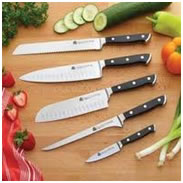Design Resource
Kitchen Products
The Sanctum Sanctorum of the Indian household
by
Kitchen knives are certainly among the most important tools in a kitchen. A good knife goes a long way in making the cooking process easier. Whether one is a professional cook or a home maker, knives play an invaluable role in the kitchen. It is important to choose the best kitchen knives to suit the cooking needs.
Earlier in the Indian kitchens the “sitting down” knife was the preferred option compared to a handheld knife.
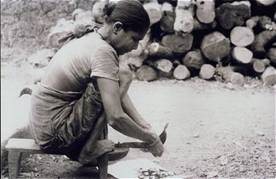
Woman sitting down to cut vegetables
[Image source]
The "sitting down” knife is stationary and the vegetable/ fruit/item to be cut is moved over the curved blade. Simultaneous use of both the hands produces a very controlled cut. It is also the fastest way to grate a coconut. This is a large item that would occupy a lot of place and had to be stored rightly too in the kitchen to avoid accidents.
In the handheld knife the vegetable/ fruit/item to be cut remains stationary and the knife is moved over to create the cuts. This is a small item and can be easily stored in a kitchen.
From general-purpose knives to specialized knives - there is a wide variety of hand held kitchen knives in the market. Using the right knife for the right purpose makes the kitchen tasks much easier and enhances the cooking experience.
Before buying a kitchen knife aspects like durability, sharpness, comfort and cost need to be considered. The need for specialist chef's knives may or may not arise in a regular kitchen. Based on one’s needs, a utility knife which helps in carving, slicing and peeling would suffice. Other kitchen essential knives include the peeling knife which is generally used for round vegetables; paring knife which is used for slicing and paring fruits/vegetables; a chef's knife for dicing and a bread knife.
As cost is a major factor in deciding which knives to buy, an economical option would be to invest in a knife set.
Types
There are seven basic types of kitchen knives in a complete kitchen knife set:
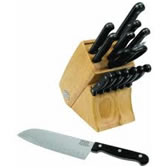
Kitchen knife set
[Image source]
• Chef knife: This type of kitchen knife has a heavy, long blade and a sharp edge. It is used for chopping, mincing, and dicing fruits and vegetables.
• Boning knife: This is a kitchen knife used to remove bones from the flesh of meat like poultry, fish etc. It is a shorter knife with a flexible, curved blade.
• Bread knife: A bread knife is a longer knife, about ten inches long, with a serrated blade. The serrated blade is good for sawing through bread crusts without dulling the blade, and cutting the bread without crushing it.
• Paring knife: This kind of kitchen knife has a short, sharp blade, used for peeling fruits, or making decorative garnishes out of fruits and vegetables.
• Filet knife: A filet knife has a flexible, curved blade, and it is used for cutting meats and fish into thin filets.
• Utility knife: A utility knife is somewhat smaller than a chef knife, about five to eight inches long. It is used for cutting meats and cheeses.
• Steak knife:This type of kitchen knife usually comes in a set. They are good for cutting tough foods into manageable bites. They have short, often serrated, blades, and are often used in table settings.
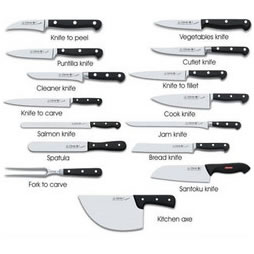
Different types of knives normally used for different purposes.
[Image source]
Materials Used
Materials that are normally used for making the blades of the kitchen knives are brass, stainless steel, carbon steel, and galvanized mild steel. Most kitchen knives are made from stainless steel. Stainless steel contains chromium, which has the benefit of making the knife blade resistant to tarnish and rust. The drawback to stainless steel is it dulls more quickly than high carbon steel. These materials provide durability, strength, finishing, and sharpness to the blades.
The handles for the knives are made of different types of materials like wood, plastic, metal etc. and can be of different shapes too.
Some examples of the types of knives available in the Indian market are shown below
These are made of stainless steel and are fitted with a moulded plastic handle riveted to the blade. The set consists of one big knife for cutting mutton, chicken etc along with other smaller knives.
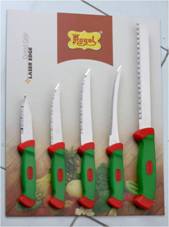
Different types of knives sold as a set
[Image source]
The knife blades in this set are made from surgical stainless steel and the handle is made from plastic material and soft grip material.
Sometimes knives are available as sets of two or three along with a peeler too.
Peelers
A peeler is used to remove the outer skin or peel of vegetables like carrots, cucumbers, potatoes and fruits such as apples, pears etc.
Peelers have a metal blade made of high quality stainless steel attached to a wooden, metal or plastic handle but nowadays there are many more varieties - fruit specific and vegetable specific peelers, household peelers, commercial peelers etc.
The most common design involves a long slightly curved steel blade (with or without serrations on the outer edges) with a special detail attached to a handle made of plastic, or a combination of plastic and steel, or wood. The vegetable or fruit to be peeled is held in one hand and the peeler is used with the other hand. The peeler is held on the surface of the vegetable or fruit and pulled with a little pressure from the top to the bottom in one long stroke carefully to remove a peel. Similar strokes done around the vegetable or fruit, will completely remove the outer skin.
Small items can be held in the hand and peeled. Large items can be held on a chopping board and similar long strokes when made from left to right or top to bottom (as is convenient to the user) complete the peeling job.
Some peelers have ergonomically designed handles that are shaped to fit the natural contours of a closed palm, so that the hand is in its most natural position while gripping and using the peeler. Ergonomic handles are believed to help reduce hand and wrist strain.
Stainless steel peeler with steel and plastic handle
Graters
A grater is a utensil with sharp perforations for shredding foods like vegetables or cheese.
The cheese grater was invented by Issac Hunt in the 1540s so hard cheeses could be used easily in cooking.
Graters come in several shapes- the most popular ones are the flat types or the cylindrical and box-shaped types.
A box grater is a stainless steel 4 sided kitchen utensil. Each side of the box has a different grating surface with different sizes of grating slots ranging from fine to coarse. They are used to reduce hard foods to small particles or long, thin strips.
Most graters are made of metal mostly stainless steel that has been perforated with sharp edged, small or medium-size holes or slits. Many have handles at the top made either out of plastic or stainless steel for a sure grip. Graters made of stainless steel will not rust, whereas those of tinned steel usually do.
Some graters are made like the lids of a box so that whatever food is grated is collected neatly in a container below. The grater is usually made of stainless steel and the container below is made of plastic, which is easy to use, clean and store too.
Uses
Several types of graters have different sizes of grating slots, and can therefore aid in the preparation of a variety of foods. They are commonly used to grate cheese, vegetables like carrots, beetroot, and lemon or orange peel (to create zest), and can also be used to grate other soft foods.
In tropical nations, graters are also used to grate coconut.
In Jamaica, a coconut grater is used as a traditional musical instrument (along with drums, fife, and other instruments) in some traditional performances.
Different types of stainless steel graters


